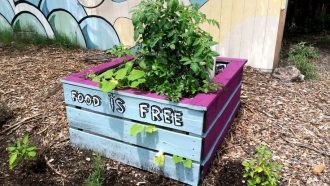Contributing writer for Wake Up World
“When life gives you lemons, share them with neighbors!” enthuses the Food is Free Project, a grassroots organization based out of Austin, Texas. The project isn’t advocating sharing bad luck; instead, it’s championing the idea of connecting neighbors and communities with a bounty of free, homegrown fresh produce.
It all began as a single, front yard organic vegetable garden with a sign explaining that the food was free for the taking. The sign also included contact information for those who wanted to learn more about growing food in a simple manner. The magic of the project is rooted in an economical, self-watering raised bed that “introduces people to a very easy method of growing organic food with very little work,” states the organization. Launched in January 2012, within three months, a majority of the surrounding neighborhood was on-board with their own front yard community gardens. But it didn’t stop there. The idea has spread around town and across the nation.
Build your own self-watering garden
The founders of the project realized that most people don’t grow their own food because of financial considerations, as well as the time it takes to maintain the plot. Through an ingenious and easy-to-build design — which uses recycled materials — participants can have a flourishing garden up and running in very little time. The best part, however, is that the bed only needs to be watered once every 2-4 weeks. This not only reduces time spent on upkeep but also drastically lowers the amount of water used. Another advantage is that there is no need to invest in building materials or an expensive drip system. The bed utilizes recycled wood pallets, scrap PVC pipes and wood, tumbled glass from the landfill, donated soil, burlap, political signs and (for the cost of around $2.00) a plastic tarp. The bed takes about 30 minutes to build — or less, once you get the hang of it.
A fun video demonstrating how to build the raised bed, along with a wealth of other gardening resources, is included below, courtesy of the Food is Free Project website. Examples of additional drought-resistant techniques include wicking 5-gallon bucket planters, watering with buried clay pots, Hugelkultur beds and a documentary about growing with mulch.
Make the existing model obsolete
As wisely observed by Buckminster Fuller, “You never change things by fighting the existing reality. To change something, build a new model that makes the existing model obsolete.” In the face of devastating droughts spreading throughout California and the Southwest, something has to give in the way that we approach agriculture. No longer do we have the luxury of a “business as usual” orientation with wasteful watering practices. By embracing drought-tolerant, small-scale and local growing methods, each one of us can ease the burden on water resources, cut down on pollution, relieve hunger with nourishing food, connect with our neighbors and save money to boot. It’s a win-win situation all the way around.
Article Sources
- http://foodisfreeproject.org
- http://www.healthy-holistic-living.com
- http://permaculturenews.org
- http://science.naturalnews.com
Previous articles by Carolanne:
- Common Toxin in Your Pantry Causes Obesity, Diabetes, Infertility… and Much More
- Is Mold Making You Sick?
- Hemp – The Ultimate Cash Crop, Health Food and Environmental Savior Rolled Into One
- Slash your Organic Food Bill by Almost 90 Percent with This One Simple Method
- Confirmed by Science: You Really Can Change Your DNA – Here’s How
-
Chemtrails: Learn How to Protect Yourself From These Treacherous Poisons
- Top 10 Food Frauds: Formaldehyde, Plastic, Melamine & Caustic Soda Found in Common Foods
- Autistic Boy With Higher IQ Than Einstein Discovers Gift After Removal From State-Run Therapy
-
Enhance Spiritual, Mental and Physical Well-being with a Pineal Gland Detox
- Enterprising Community Aims for Total Food Self-Sufficiency with Free Edible Landscapes
- The Silent Toxin in Food that Provokes Cancer, Diabetes, Multiple Sclerosis and More
About the author:
I’m Carolanne — a writer, chef, traveler and enthusiastic advocate for sustainability, organics and joyful living. It’s good to have you here. If you would like to learn more, connect with me at Thrive-Living.net or visit Twitter.com/Thrive_Living.
If you've ever found value in our articles, we'd greatly appreciate your support by purchasing Mindful Meditation Techniques for Kids - A Practical Guide for Adults to Empower Kids with the Gift of Inner Peace and Resilience for Life.
In the spirit of mindfulness, we encourage you to choose the paperback version. Delve into its pages away from screen glare and notifications, allowing yourself to fully immerse in the transformative practices within. The physical book enriches the learning process and serves as a tangible commitment to mindfulness, easily shared among family and friends.
Over the past few years, Wake Up World has faced significant online censorship, impacting our financial ability to stay online. Instead of soliciting donations, we're exploring win-win solutions with our readers to remain financially viable. Moving into book publishing, we hope to secure ongoing funds to continue our mission. With over 8,500 articles published in the past 13 years, we are committed to keeping our content free and accessible to everyone, without resorting to a paywall.
Please note: this article was first published on Natural News.








